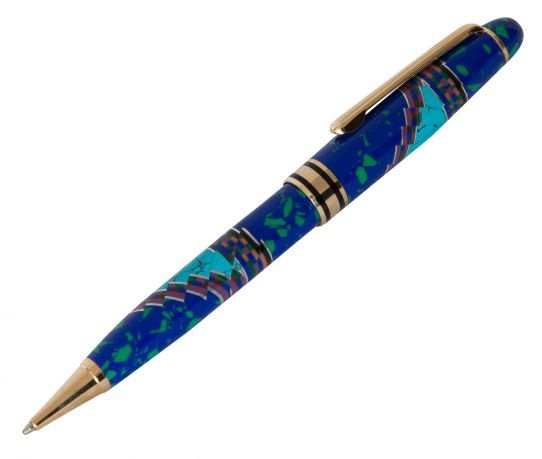We use cookies to make your experience better.
Luxury pen from the Zuni Indians of America
- Buy 3 for €25.00 each and save 14%
Indians are the original inhabitants of America. Columbus, who thought in 1492 to be in India ended (it was his intention to close westbound Atlantic journey and to arrive in India) resident called indios - Indians. Because the name "Indian" assumes a Western point of view, there are several alternative names in vogue. In the United States introduced the US government and academics in the 60s of the 20th century the term Native American (Dutch: Native American) for the groups falling under the responsibility of the Bureau of Indian Affairs. An additional reason was the confusion with people of Indian origin, which in English are also called Indians. This new terminology, however, was not widely appreciated, because it was adopted without the participation of those involved, and because with this term Indians and the indigenous people of Alaska, Hawaii, Puerto Rico and the islands in the Pacific were lumped together. In a 2005 by the US Census Bureau survey showed that nearly 50% of the Indians prefer "American Indians" contracts, while slightly more than 37% prefer "Native American". Nowadays, both terms are used. It is noteworthy that the Bureau of Indian Affairs now uses the term American Indian rather than Native American. The term First Nations / Premières Nations is being used in Canada. In Latin America, the Indians are officially called indígenas (natives). In the scientific world, one also speaks of Amerindians or Amerindians. The Eskimos (sometimes called Inuit, all strikes that word not strictly on the Yupik in Alaska) are very often (in politics and in science) are not considered as Indians, albeit as "Native Americans". The emancipation which ethnic naming is concerned, both in Canada and the US are increasingly a thing of the indigenous communities themselves, which culturally and politically ever (itself) be aware. So give indigenous peoples are officially recognized by the US and Canadian governments and regard themselves as a mature political and cultural state, increasingly often no longer (as in the US) tribes (tribes), or (as in Canada) bands called wanting are, however Nations (nations or states). Also, the names that Europeans (or surrounding indigenous peoples) introduced in the past, more and more replaced by the names that people gave to themselves. Instead of Iroquois example, we speak often of Haudenosaunee. Other name changes include Lakota (Dakota / Nakota) Sioux, Mexicah for Aztecs, Mixtecs and Ñudzahui for Mapuche for Araucaniërs. "Indian" in Dutch not capitalized because it is not a nation but suggests several ethnic groups (like gypsies is the case). King William I then called his subjects in the Dutch East Indies in a number of his royal decrees "Indians." "Inlander" however became the common term. Upon the arrival of Columbus North America was divided into a number of culture regions. The best known are those of the far north (Arctic) and that of the prairies in the Midwest, the Great Plains. On the Plains, most people lived along the rivers and were farmers. In the east and southwest of North America also attended farmers. The main crops were corn, beans and pumpkins. These were originally from Mexico. Furthermore, cotton grown in the southwest and to the east include sunflowers. Tobacco was planted in nearly the entire current US and southern Canada. The stereotypical image of "the Indian" is based on the Plains peoples of the nineteenth century. This is not to say that Columbus (without horses!) No hunting was made on the bison and other animals. Especially in the northern part of the Great Plains are many so called "Buffalo Jumps". Here ere hunted bison in a ravine, where they fell to pieces. In Buffalo Jump Head-Smashed-In Alberta, Canada, a museum where you can see how this went into his work.
The mineral turquoise is a hydrated copper-aluminum-phosphate with the chemical formula CuAl6 (PO4) 4 (OH) 8 · 4 (H 2 O). The green, yellow, gray, light blue, but typical blue green turquoise has a wasglans a pale blue and white stripe color. The crystal system is triclinic and the cleavage is perfect according to the crystal surface [001] as well [010]; moreover it almost comes only forms cryptocrystalline for so fission in practice to observe. The average density is 2.7 and the hardness is from 5 to 6. Turquoise is not radioactive. The mineral turquoise is named after Turkey, the country through which it passed when the mineral first reached Europe; otherwise it is not known to be in Turkey. The color turquoise is named after this mineral. Turquoise is primarily found as a secondary mineral in copper ores. The type of location is the deposition Nishapur in Iran. Also in the Sinai and the mineral was mined in Serabit el-Khadim is a temple dedicated to the Egyptian "Lady Torquoise" (the goddess Hathor). Turquoise is used as a gemstone. During the Ottoman Empire was turquoise and precious mineral exports, especially to Persia. Currently turquoise is mined in Mexico, the United States, China and Iran. Imitation Turquoise was made for the first time in 1972 in France, but the properties of these imitation different from those of the natural varieties. Yet the best-selling turquoise now synthetic.
| Dimensions | 140mm |
|---|












